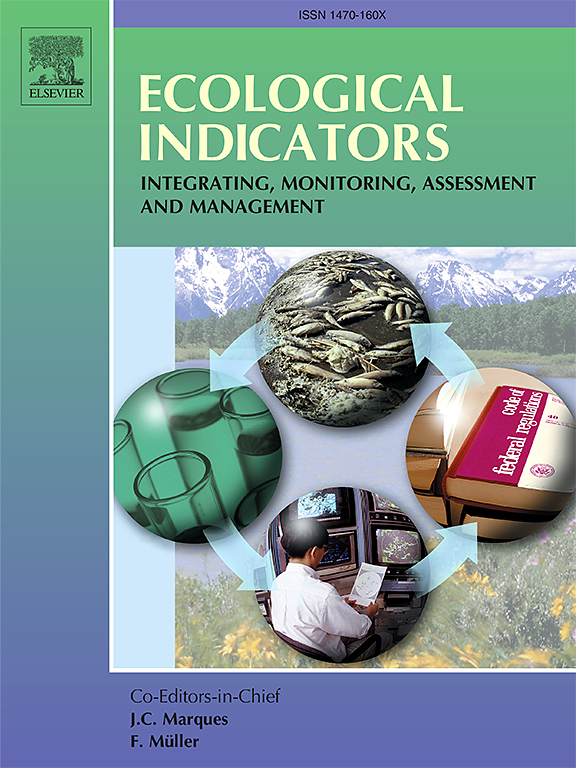基于改进VORS模型的南水北调中线工程生态健康评价
IF 7
2区 环境科学与生态学
Q1 ENVIRONMENTAL SCIENCES
引用次数: 0
摘要
南水北调中线工程的实施,极大地缓解了中国北方及其沿线受水区的缺水问题。然而,它对生态系统健康(EH)的影响也是深远的。本研究以三峡工程中线沿线的27个城市区域为研究对象。以2000 - 2022年土地利用数据和Landsat影像为基础,构建了基于遥感生态指数(RSEI)的“活力-组织-弹性-服务(VORS)”研究基线。本研究采用Invest模型对2000 - 2022年生态系统服务供给进行了定量评价,揭示了调水前后生态系统生态环境的变化。研究结果表明:2000 ~ 2022年,中国土地利用以耕地、林地和草地为主,土地类型转换频繁;耕地净损失达1 140 052公顷,主要是由于转为建筑用地。总体而言,EH有所改善,空间分布格局显示西南地区优于东北地区。受土地利用变化的影响,京津冀地区的生态环境指数仍处于次优状态。在调水前(2000-2015年),EH略有下降,生态系统组织(EO)、生态系统恢复力(ER)和生态系统服务(ES)值均有所下降。相反,生态系统活力(EV)值显著增加。调水后(2015-2022)EH明显增加。除ES值略有下降外,其他指标值均有不同程度的改善。本文章由计算机程序翻译,如有差异,请以英文原文为准。
Ecological health assessment of the middle route of the South-to-North Water Diversion Project using an enhanced VORS model
The Middle Route of China’s South-to-North Water Diversion Project (MR-SNWDP) has substantially alleviated water scarcity in northern China and the water-receiving regions along its route. However, its impact on ecosystem health (EH) is also profound. This study focuses on the 27 urban regions along the middle route of the MR-SNWDP. Using land use data from 2000 to 2022 and Landsat imagery as a foundation, it constructs a research baseline based on remote sensing ecological indices (RSEI) for “vigor-organization-resilience-service (VORS)”. The study employs the Invest model to quantitatively assess ecosystem service provision from 2000 to 2022, revealing changes in EH before and after the water transfer. The research findings indicate that, between 2000 and 2022, land use was predominantly composed of cropland, forest land, and grassland, with frequent conversions between land types. The net loss of cropland reached 1,140,052 hm2, primarily due to conversion into built-up land. Overall, the EH has improved, with a spatial distribution pattern showing that the southwest region exhibits better conditions compared to the northeast. Due to land use changes, the EH in the Beijing-Tianjin-Hebei (BTH) region has remained suboptimal. In terms of periods, prior to the water transfer (2000–2015), EH slightly declined, with reductions in ecosystem organization (EO), ecosystem resilience (ER), and ecosystem service (ES) values. Conversely, the ecosystem vigor (EV) value showed a notable increase. After the water transfer (2015–2022), EH showed a marked increase. Except for a slight decrease in ES values, all other indicator values exhibited varying degrees of improvement.
求助全文
通过发布文献求助,成功后即可免费获取论文全文。
去求助
来源期刊

Ecological Indicators
环境科学-环境科学
CiteScore
11.80
自引率
8.70%
发文量
1163
审稿时长
78 days
期刊介绍:
The ultimate aim of Ecological Indicators is to integrate the monitoring and assessment of ecological and environmental indicators with management practices. The journal provides a forum for the discussion of the applied scientific development and review of traditional indicator approaches as well as for theoretical, modelling and quantitative applications such as index development. Research into the following areas will be published.
• All aspects of ecological and environmental indicators and indices.
• New indicators, and new approaches and methods for indicator development, testing and use.
• Development and modelling of indices, e.g. application of indicator suites across multiple scales and resources.
• Analysis and research of resource, system- and scale-specific indicators.
• Methods for integration of social and other valuation metrics for the production of scientifically rigorous and politically-relevant assessments using indicator-based monitoring and assessment programs.
• How research indicators can be transformed into direct application for management purposes.
• Broader assessment objectives and methods, e.g. biodiversity, biological integrity, and sustainability, through the use of indicators.
• Resource-specific indicators such as landscape, agroecosystems, forests, wetlands, etc.
 求助内容:
求助内容: 应助结果提醒方式:
应助结果提醒方式:


